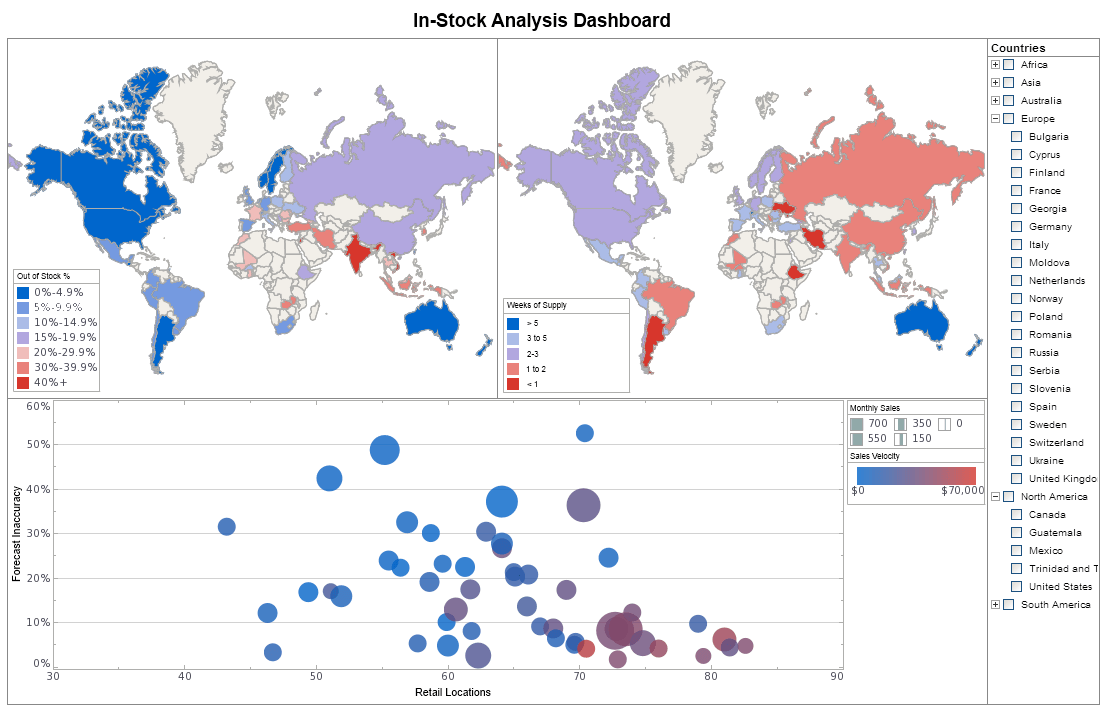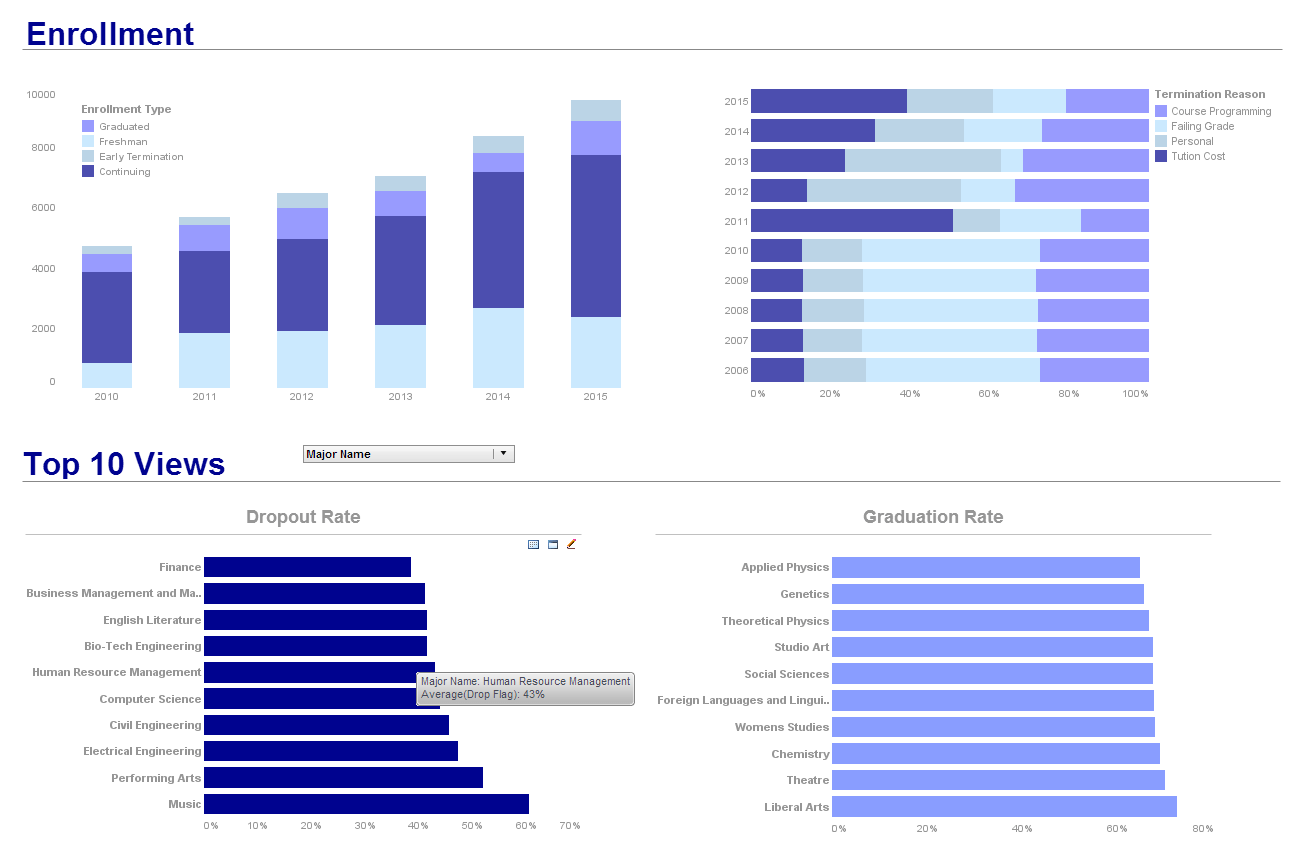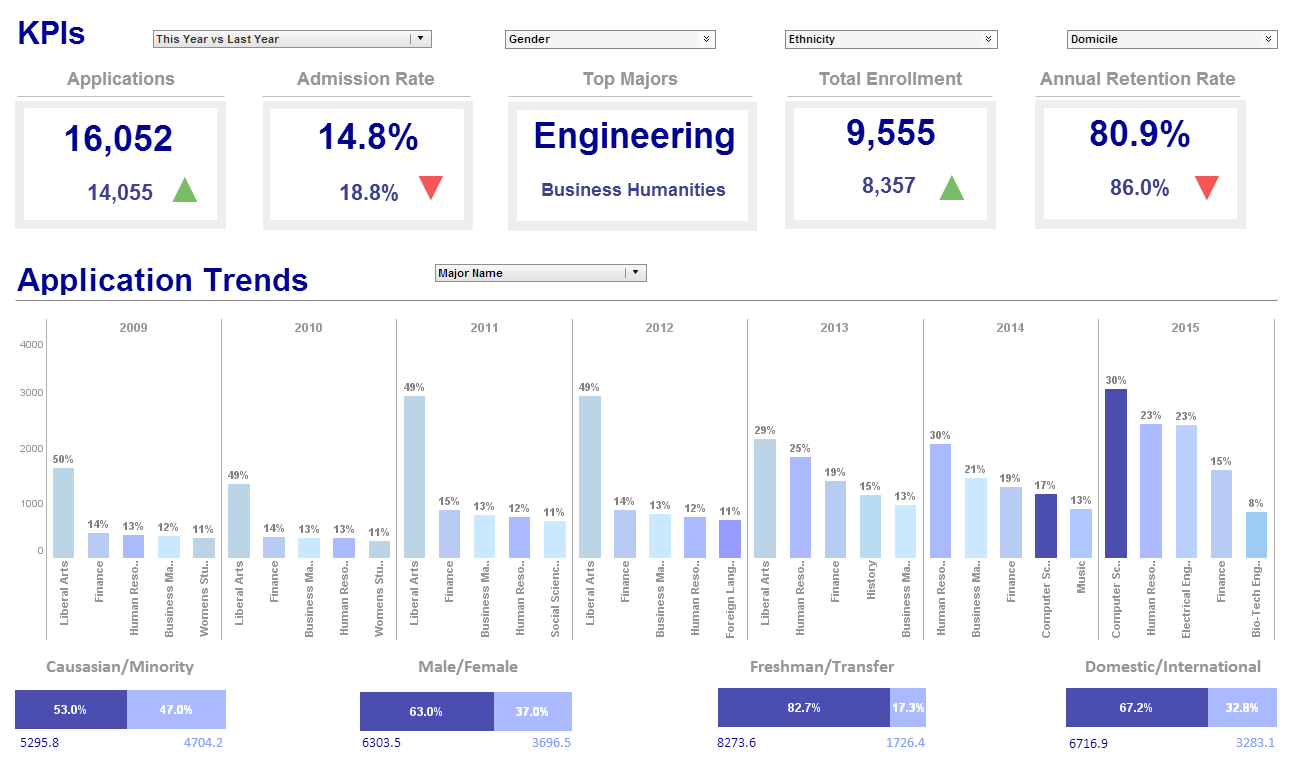InetSoft Technology: A Pioneering Dashboard Company
Are you looking for good dashboard company? Since 1996 InetSoft has been making dashboard software that is easy to deploy and easy to use. Build self-service oriented interactive dashboards quickly. View a demo and read reviews.

Why InetSoft?
InetSoft's company dashboard software is easy enough to be:- Deployed in just weeks
- Learned by end users with minimal training
- Used by any executive without the aid of IT
- Adaptable to changing data and business needs
- Used for data exploration through visualization
- Capable of maximum self-service
- Attract the attention of executives
- Meet the demands of power users
- Scale up for organizations of any size
Evaluate Style Scope from InetSoft. It's Easy. Agile. & Robust.
Register for more info and to download free software
About InetSoft
Since 1996 InetSoft has been delivering easy, agile, and robust business intelligence software that makes it possible for organizations and solution providers of all sizes to deploy or embed full-featured business intelligence solutions. Application highlights include visually-compelling and interactive dashboards that ensure greater end-user adoption plus pixel-perfect report generation, scheduling, and bursting. InetSoft's patent pending Data Block™ technology enables productive reuse of queries and a unique capability for end-user defined data mashup.
This capability combined with efficient information access enabled by InetSoft's visual analysis technologies allows maximum self-service that benefits the average business user, the IT administrator, and the developer. InetSoft was rated #1 in Butler Analytics Business Analytics Yearbook, and InetSoft's BI solutions have been deployed at over 5,000 organizations worldwide, including 25% of Fortune 500 companies, spanning all types of industries.

Case Study: Elite Aesthetics Plastic Surgery Clinic - Enhancing Operational Efficiency and Patient Care with Dashboards
Elite Aesthetics is a prominent plastic surgery clinic located in a bustling metropolitan area. Established in 2010, the clinic offers a wide range of cosmetic and reconstructive procedures, including rhinoplasty, breast augmentation, liposuction, facelifts, and minimally invasive treatments like Botox and fillers. Elite Aesthetics is renowned for its personalized patient care, cutting-edge technology, and highly skilled surgeons, attracting a diverse clientele from across the region.
As the clinic grew in popularity, it faced several operational challenges related to managing patient appointments, tracking surgical outcomes, monitoring financial performance, and maintaining high standards of patient care. To address these challenges and support data-driven decision-making, Elite Aesthetics implemented a suite of dashboards designed to provide real-time insights into various aspects of its operations.
Challenges Faced by Elite Aesthetics
- Patient Appointment Management:
- The clinic's increasing patient volume made it challenging to efficiently manage appointment schedules, leading to potential overbooking, long wait times, and underutilization of operating rooms.
- Surgical Outcome Tracking:
- As a leading plastic surgery provider, Elite Aesthetics needed to monitor the outcomes of its procedures to ensure consistent quality and patient satisfaction. Tracking these outcomes manually was time-consuming and prone to errors.
- Financial Performance Monitoring:
- With multiple revenue streams, including surgical procedures, non-surgical treatments, and product sales, the clinic required a robust system to track financial performance and identify areas for improvement.
- Patient Satisfaction and Feedback:
- Maintaining high levels of patient satisfaction was critical for the clinic's reputation. The clinic needed a way to systematically collect and analyze patient feedback to address concerns and enhance the patient experience.
- Regulatory Compliance and Reporting:
- The plastic surgery industry is heavily regulated, requiring the clinic to maintain detailed records of procedures, patient outcomes, and safety protocols. Ensuring compliance with these regulations was a significant administrative burden.
Solution: Implementation of Dashboards
To tackle these challenges, Elite Aesthetics adopted a series of customizable dashboards that integrated data from various sources, including patient management systems, financial software, and feedback platforms. These dashboards provided real-time visibility into the clinic's operations, enabling the team to make informed decisions quickly and efficiently.
Key Features of the Dashboards
- Appointment Management Dashboard:
- Real-Time Scheduling: The appointment management dashboard offered a real-time view of the clinic's schedule, including patient appointments, consultations, and surgeries. It allowed the clinic staff to optimize scheduling, minimize wait times, and ensure efficient use of operating rooms.
- Automated Reminders: The dashboard included an automated reminder system that sent notifications to patients about upcoming appointments, reducing no-show rates and improving patient adherence to post-operative care instructions.
- Utilization Metrics: The dashboard tracked the utilization rates of surgeons, operating rooms, and equipment, providing insights into capacity planning and resource allocation.
- Surgical Outcomes Dashboard:
- Procedure Tracking: This dashboard allowed the clinic to track the outcomes of all surgical procedures, including complication rates, patient satisfaction scores, and recovery times. The data was categorized by surgeon, procedure type, and patient demographics.
- Outcome Benchmarking: The dashboard enabled the clinic to benchmark its surgical outcomes against industry standards and peer clinics. This helped Elite Aesthetics identify areas where it excelled and areas that required improvement.
- Patient Follow-Up Monitoring: The dashboard tracked post-operative follow-ups, ensuring that patients received timely care and that any complications were addressed promptly.
- Financial Performance Dashboard:
- Revenue Analysis: The financial dashboard provided a comprehensive overview of the clinic's revenue streams, breaking down income by procedure type, surgeon, and service. It also tracked the profitability of each service line, helping the clinic identify its most lucrative offerings.
- Expense Management: The dashboard monitored the clinic's expenses, including staffing costs, medical supplies, and overheads. This allowed management to identify cost-saving opportunities and improve overall financial efficiency.
- Profit Margin Tracking: The dashboard calculated the clinic's profit margins in real-time, providing insights into financial performance and guiding strategic decisions, such as pricing adjustments and investment in new technologies.
- Patient Satisfaction Dashboard:
- Feedback Collection: The patient satisfaction dashboard aggregated feedback from various sources, including post-procedure surveys, online reviews, and direct patient comments. This provided a holistic view of patient sentiment.
- Net Promoter Score (NPS): The dashboard tracked the clinic's Net Promoter Score, a key indicator of patient loyalty and satisfaction. A high NPS suggested that patients were likely to recommend the clinic to others, while a low score highlighted areas for improvement.
- Issue Resolution Tracking: The dashboard included a feature for tracking the resolution of patient complaints and concerns, ensuring that all issues were addressed in a timely and satisfactory manner.
- Compliance and Reporting Dashboard:
- Regulatory Compliance Monitoring: This dashboard helped the clinic ensure compliance with industry regulations by tracking key metrics such as documentation completeness, safety protocol adherence, and staff certification statuses.
- Audit Preparation: The dashboard streamlined the process of preparing for audits by organizing all necessary documentation and providing easy access to compliance reports. This reduced the administrative burden and minimized the risk of non-compliance penalties.
- Quality Control Metrics: The dashboard tracked quality control metrics, such as infection rates and patient safety incidents, helping the clinic maintain high standards of care and safety.
Benefits of Using Dashboards at Elite Aesthetics
- Improved Operational Efficiency:
- The implementation of dashboards allowed Elite Aesthetics to streamline its operations, reducing the time spent on manual data entry and reporting. Real-time insights enabled the clinic to optimize scheduling, resource allocation, and financial management, leading to more efficient operations.
- Enhanced Patient Care and Satisfaction:
- By tracking surgical outcomes and patient feedback, the clinic was able to continuously improve its services and address patient concerns promptly. This led to higher patient satisfaction scores, increased referrals, and a stronger reputation in the community.
- Better Financial Performance:
- The financial performance dashboard provided the clinic with a clear understanding of its revenue and expenses, allowing management to make data-driven decisions that improved profitability. The ability to track profit margins and identify cost-saving opportunities helped Elite Aesthetics maintain a healthy financial position.
- Increased Staff Productivity:
- The dashboards reduced the administrative burden on clinic staff by automating many routine tasks, such as appointment reminders and compliance reporting. This allowed staff to focus more on patient care and other high-value activities, improving overall productivity.
- Regulatory Compliance and Risk Management:
- The compliance dashboard ensured that Elite Aesthetics adhered to all relevant regulations and industry standards. This reduced the risk of legal issues and penalties, while also ensuring that the clinic maintained its reputation for safety and quality.
Challenges Encountered
While the adoption of dashboards brought significant benefits, Elite Aesthetics faced some challenges during the implementation process:
- Data Integration and Compatibility:
- Integrating data from various sources, such as electronic health records (EHRs), financial systems, and patient feedback platforms, required significant effort. The clinic had to work closely with its software provider to ensure that all systems were compatible and that data was accurately transferred and synchronized.
- User Training and Adoption:
- Some staff members were initially hesitant to adopt the new dashboard system, preferring their traditional methods. To address this, the clinic provided comprehensive training sessions and ongoing support to ensure that all employees were comfortable using the dashboards.
- Customization and Scalability:
- Customizing the dashboards to meet the specific needs of the clinic took time and required iterative development. Additionally, as the clinic continued to grow, the dashboards needed to be scalable to accommodate new locations, services, and data sources.
Results and Outcomes
The implementation of dashboards at Elite Aesthetics led to several positive outcomes:
- Increased Revenue:
- The clinic saw a 20% increase in revenue within the first year of using dashboards, driven by improved appointment scheduling, optimized resource allocation, and better financial management.
- Higher Patient Satisfaction:
- Patient satisfaction scores improved by 25%, with many patients citing the clinic's attention to detail and personalized care as key factors in their positive experiences.
- Improved Surgical Outcomes:
- The clinic achieved better surgical outcomes, with a 15% reduction in complication rates and a 10% decrease in patient recovery times, thanks to the continuous monitoring and analysis provided by the dashboards.
- Enhanced Compliance:
- The clinic passed several regulatory audits with ease, thanks to the compliance dashboard's ability to streamline documentation and reporting processes. This helped Elite Aesthetics avoid potential fines and maintain its reputation for safety and quality.
- Operational Growth:
- With the efficiencies gained through the use of dashboards, Elite Aesthetics was able to expand its services and open a new location, confident in its ability to manage operations effectively across multiple sites.
More Articles About Dashboards
Energy and Utilities Dashboard Software - Now that we've covered the key ways that dashboard software can power up the energy and utilities sector, we're going to look at our power management example. Focused on generation and distribution, this dynamic piece of BI software is ideal for energy and utility providers as well as businesses that consume large levels of energy across sites or branches. Designed with clear cut visual KPIs as well as easy-to-navigate data filter functionality, you can drill down into a wealth of emerging trends and patterns in moments...
How to Make a Regional Map in InetSoft - To display data on a map by region (state, city, zip code, etc.), follow the steps below:: Prepare Your Data The data source for the chart (data block, query, or data model) should represent dimensions and measures as independent columns or fields, including a date column, as shown below. See Prepare Your Data for information on how to manipulate your data, if it is not currently in this form. (Note: A properly designed data model will already have the correct structure...
InetSoft vs. InsightSquared Comparison - Reviewers were impressed that InetSoft's data mashup capabilities and worksheets allowed for an Excel-like interface for data browsing. As the pioneer of data mashup technology, InetSoft's platform can take data from almost any source and mash it into data blocks that allows for complete data queries in a drag-and-drop environment. This means business users can build a platform that works specifically for their data and enterprise. This ease of customization bypasses the need to purchase prebuilt dashboards which contain outdated and irrelevant information...
Toy Manufacturer Data Mash Up - A data analyst at a toy manufacturer would likely mash up data from various sources to gain comprehensive insights into different aspects of the business and the market. Some potential data sources that a data analyst at a toy manufacturer might mash up include: Sales Data: Sales data from internal systems would provide valuable information about which toys are selling well, trends over time, and regional variations in sales. This data could include information such as product SKUs, sales quantities, revenue, and customer demographics. Inventory Data: Inventory data would allow the analyst to understand stock levels, turnover rates, and potential supply chain bottlenecks...

